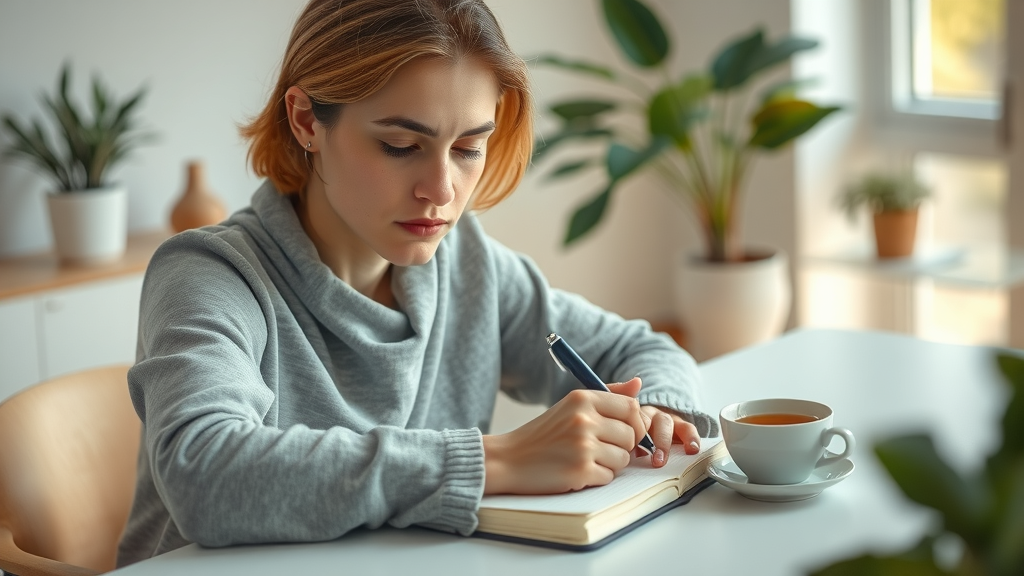Did you know? According to the American Institute of Stress, 77% of people regularly experience physical symptoms caused by stress. Stress has become an almost universal part of modern life—affecting our mental health, physical well-being, and how we function every day. But what if you could harness the power of your own mind to counteract stress and reset your sense of calm? This comprehensive guide will walk you through everything you need to know about using self-hypnosis for daily stress relief—from the eye-opening science, to step-by-step techniques for real-life success. If you're seeking practical, evidence-based ways to manage stress and support a healthier, more resilient you, you're in the right place.
Startling Statistics: How Stress Impacts Daily Life
"According to the American Institute of Stress, 77% of people regularly experience physical symptoms caused by stress."
Breaking Down the Numbers on Stress and Stress Relief
Stress lurks in our workplaces, homes, and digital lives—showing up as headaches, trouble sleeping, or even chest pain. In fact, ongoing research reveals that over 60% of adults feel stressed about work, and nearly half cite personal relationships as a source of significant tension. Beyond these everyday concerns, chronic stress is closely linked to ailments impacting physical health and mental health, such as anxiety disorder, cardiovascular problems, and immune suppression. The good news? Consistent relaxation techniques and self-awareness can make stress easier to manage by calming the conscious mind and body. This is where self-hypnosis for daily stress relief enters the picture—emerging as an effective, accessible technique for breaking the cycle of chronic stress and supporting a more balanced, healthier life.
It's important to note that stress isn't always negative; in moderation, it can motivate us. Yet when it lingers and builds, stress can quickly overwhelm both our emotional regulation and decision-making ability, affecting our performance and relationships. Traditional forms of stress management—including exercise, social support, and therapy—may not always be practical for everyone in everyday life. This has sparked increased interest in mind-body techniques like hypnosis for stress. When practiced regularly, self-hypnosis can help you reduce stress and reclaim a sense of calm, providing a simple yet powerful tool for supporting stress relief right at home.

What You'll Learn About Self-Hypnosis for Daily Stress Relief
Core principles of hypnosis for stress
Step-by-step self-hypnosis techniques for stress management
How to use hypnotic suggestions for better stress relief
Tips for integrating self-hypnosis into your daily routine
The Science Behind Self-Hypnosis for Daily Stress Relief
How Self-Hypnosis Impacts Stress Management and the Mind
"Hypnosis for stress has been shown in studies to reduce anxiety and improve emotional regulation." — Dr. Andrea Wilson, Clinical Hypnotherapist
Modern neuroscience confirms what clinical hypnosis practitioners have experienced for decades: self-hypnosis for daily stress relief can help ease emotional turbulence and improve how we manage stress. By guiding your conscious mind to focus on positive, calming imagery or suggestions, you encourage a state of relaxation that makes stress and anxiety more manageable. During a self-hypnosis session, the brain shifts to slower, more ordered brainwaves, resembling a deeply relaxed state similar to meditation. This altered state primes the subconscious mind to accept beneficial hypnotic suggestions aimed at stress reduction and resilience.
Research consistently shows that people using self-hypnosis techniques report lower levels of perceived stress, enhanced ability to manage stress, and even improvements in physical symptoms like muscle tension or headaches. These results are closely tied to changes in how the brain processes information—helping to "train" relaxation as a default response. Through hypnosis for stress, your brain essentially learns new patterns that support stress relief, making it easier to respond more calmly to triggers both at work and in everyday life. This science-backed approach is why therapists increasingly recommend self-hypnosis as a powerful tool for stress management.

Understanding Hypnosis for Stress and Everyday Stress Relief
Defining Self-Hypnosis and Its Role in Stress Management
Self-hypnosis is a therapeutic technique that allows individuals to enter a deeply focused and deeply relaxed state using guided imagery, affirmations, or positive suggestions. Unlike clinical hypnosis, which is led by a trained practitioner, self-hypnosis is performed by the individual, often at home or in private settings. The process involves consciously guiding yourself into a trance-like state—somewhat lighter than sleep but more focused than ordinary thought—where your subconscious mind becomes more receptive and open to change.
In the context of stress management, self-hypnosis offers a practical, flexible option for relieving tension and supporting better mental health. With regular practice, it can interrupt stress responses, facilitate emotional release, and foster a greater sense of inner calm. By empowering yourself to use relaxation techniques and hypnotic suggestions on your own terms, you make it easier to cope with everyday challenges and reduce the build-up of unnecessary stress over time.
Examples of Hypnotic Suggestions for Managing Stress
Progressive relaxation
Positive affirmations
Visual imagery exercises
These classic self-hypnosis tools form the foundation of stress relief through mind-body focus. Progressive relaxation involves systematically releasing tension throughout the body, making it easier to manage stress and enter a relaxed state. Positive affirmations—such as "I am calm and in control"—direct the conscious and subconscious mind toward helpful, empowering thoughts. Visual imagery exercises encourage the imagination to picture peaceful scenes, supporting stress reduction and emotional comfort. When practiced regularly, these hypnotic suggestions can shape how you respond to stress and serve as a springboard for greater self-confidence and peace throughout everyday life.
Step-by-Step Guide to Self-Hypnosis for Daily Stress Relief
Preparing Your Environment for Effective Hypnosis for Stress

Achieving a successful session of self-hypnosis for daily stress relief starts with setting up an environment that encourages calm and focus. Begin by finding a quiet spot—a favorite corner of your living room or a comfortable chair away from distractions. Dim the lights or use lamps with a warm glow, and add comforting touches like a soft blanket or lightly scented candle. These details signal your mind to shift from work mode into relaxation, making it easier to transition into a deeply relaxed state. Keep any necessary tools—such as a journal or playlist of soothing music—within arm's reach for added support during your practice.
The key to an effective self-hypnosis session is removing barriers to calm. Switch off electronic notifications, and let household members know you need some undisturbed time. Simple adjustments—closing the window, adjusting your seat cushion, or sipping a warm cup of tea—can also help your body relax and your mind open up for positive change. By honoring these routines and treating your session with intention, you prime yourself for deeper, more restorative self-hypnosis and greater stress relief.
Self-Hypnosis Techniques for Stress Management
Find a quiet, comfortable space
Set a clear intention or goal for stress relief
Use relaxation breathing to enter a hypnotic state
Apply positive hypnotic suggestions
Gently return to alertness and reflect
1. Find a quiet, comfortable space: Begin your stress relief practice in a setting where you're least likely to be disturbed. This helps remove distractions and brings your conscious mind into the present.
2. Set a clear intention or goal: Whether you want to feel calmer at work or manage stress from relationship challenges, being specific anchors your session and guides your subconscious mind toward positive change.
3. Use relaxation breathing: Slowly inhale through your nose for a count of four, hold, and exhale for six. Repeating this pattern helps the body relax, quiets mental chatter, and initiates a deeply relaxed state.
4. Apply positive hypnotic suggestions: Introduce affirmations or visualizations that align with your goal, such as, "With every breath, I am letting go of tension." Imagine peaceful scenes or sensations that evoke comfort.
5. Gently return to alertness and reflect: After a few minutes, gradually wiggle your fingers and toes, and open your eyes. Jot down any insights or shifts in mood in a journal for tracking your progress with stress management and self-hypnosis over time.
Watch: A friendly expert demonstrates a simple self-hypnosis session for stress relief — focusing on breathing and relaxation in a serene setting.
Table: Comparing Self-Hypnosis to Other Stress Management Techniques
Technique |
Ease of Use |
Time Commitment |
Effectiveness |
|---|---|---|---|
Self-Hypnosis |
High |
10-20 min |
Effective for many users |
Meditation |
Medium |
10-30 min |
Widely effective |
Breathwork |
High |
5-10 min |
Quick relief |
Talk Therapy |
Low |
60 min/session |
Long-term benefits |
Incorporating Hypnotic Suggestions for Daily Stress Relief
Best Practices for Self-Hypnosis in Stress Management

Integrating self-hypnosis for daily stress relief into everyday life is most effective when combined with a consistent and open-minded approach. Begin by treating your self-hypnosis sessions as appointments with yourself for mental wellness, and experiment with various hypnotic suggestions to determine what resonates best for managing your unique stressors. Journaling before and after your sessions can reveal patterns in your stress responses and help you fine-tune your practice for better results. By repeating affirmations and relaxation techniques during stressful moments—not just in quiet sessions—you anchor calm as a dependable resource in your toolkit for stress management.
Remember that successful stress reduction doesn't happen overnight. Persistence and patience are key, as is a willingness to explore new imagery or script suggestions. Mixing self-hypnosis with other proven stress management modalities, like breathwork or guided imagery, can offer even greater support. If challenges arise or progress feels slow, consult a licensed mental health professional or clinical hypnotherapist to refine your technique or troubleshoot obstacles in your journey toward stress relief.
Troubleshooting Common Challenges with Hypnosis for Stress
Difficulty relaxing
Unrealistic expectations
Inconsistent routine
Some people may initially struggle with self-hypnosis because they find it hard to settle into a relaxed state. If this happens, try shorter sessions and use calming music or guided audios to ease in. Others may expect instant results—it's important to remember that, like any skill, self-hypnosis becomes more powerful with regular practice over weeks, not days. If you notice your routine slipping, set specific reminders or tie your session to another habit (like journaling or morning tea) to reinforce consistency. Adjust your hypnotic suggestions over time and remain flexible; even a few minutes daily can support stress relief and improve your mental health long-term.
Can self-hypnosis help anxiety?
Understanding the Connection Between Self-Hypnosis for Daily Stress Relief and Anxiety
Yes, self-hypnosis for daily stress relief has been shown to be beneficial for anxiety as well as general stress. By training the mind to enter a calm, focused state, self-hypnosis provides tools for interrupting anxious thoughts and minimizing the physical symptoms of anxiety disorder—such as rapid heartbeat or tense muscles. Research on hypnosis for stress and anxiety management finds that, for many people, self-hypnosis can supplement or enhance the effects of other therapies, including cognitive behavioral therapy or behavioral therapy. As always, persistent anxiety should be discussed with a healthcare provider to determine the best course of treatment for your needs.
The practical techniques used in self-hypnosis—like guided imagery and progressive relaxation—help anchor the mind during moments of overwhelm. People who practice regularly find they are better able to manage stress, experience fewer anxious episodes, and report a more balanced mood in everyday life. As a non-invasive and drug-free treatment option, self-hypnosis remains a valuable tool for many seeking a more empowered approach to stress reduction and mental wellness.
Is it okay to do hypnosis every day?

Absolutely! Practicing self-hypnosis for a few minutes each day is both safe and can be highly beneficial for stress management. By incorporating hypnosis for stress as a regular habit—much like brushing your teeth or stretching before bed—you can strengthen your ability to relax, focus, and manage everyday stressors. Most people see the best results from daily or near-daily sessions, as this creates a routine for the subconscious mind to anticipate and respond with greater relaxation over time.
If you ever feel too drowsy or have trouble resuming normal activities after a session, simply shorten your practice or try a different time of day. As with any mind-body technique, consistency and self-awareness are your best guides. Self-hypnosis can be combined with other methods—such as meditation or therapy—to form a robust support system for mental health in everyday life.
What are examples of everyday hypnosis?

Everyday hypnosis occurs naturally in many situations—often without us even realizing it. Ever found yourself zoning out while listening to music, getting absorbed in a book, or daydreaming during your commute? These "trance-like" moments are mild forms of self-hypnosis, where your mind becomes so focused that external distractions fade away. You might notice a similar sensation when running, painting, or getting lost in a movie—all activities that shift attention from the conscious mind to the subconscious mind and bring about a sense of peace or flow.
Recognizing these everyday examples can make it easier to harness self-hypnosis for daily stress relief intentionally. Next time you find yourself caught in a repetitive or calming activity, pause to observe your breathing, thoughts, or physical sensations—it’s a reminder that you naturally possess the capacity to relax your mind and body, making stress management more accessible than you might think.
Can I learn self-hypnosis on my own?
Yes! You don’t need to be an expert or seek out clinical hypnosis to get started. Many people successfully learn self-hypnosis for daily stress relief using simple instructions, online videos, or guided audios found through reputable mental health organizations. The most important factors for success are an open mind, a willingness to try, and patience as you develop your own rhythm and favorite stress relief techniques.
If you are navigating longstanding anxiety or particularly complex stressors, working with a licensed hypnotherapist or healthcare provider can provide extra support. For most people, though, the basics of self-hypnosis are safe, easy to learn, and highly effective for everyday use—especially when combined with journaling, positive suggestions, and other relaxation techniques.
FAQs About Self-Hypnosis for Daily Stress Relief
How long should a self-hypnosis session last for stress management?
Most self-hypnosis sessions last between 10 and 20 minutes. The ideal length is the amount of time it takes for you to enter a relaxed state, run through your affirmations or guided imagery, and gently return to alertness. Shorter daily sessions can support stress relief as effectively as longer ones, especially when practiced consistently.Are there risks to using self-hypnosis for stress relief?
For most people, self-hypnosis is considered safe and poses little risk. If you have a diagnosed mental health condition or a history of dissociation, it's best to consult a professional before starting. Avoid practicing self-hypnosis while driving or performing tasks that require full alertness.What is the difference between self-hypnosis and guided hypnosis for stress?
Self-hypnosis is performed independently, with you taking yourself through the process and choosing your own suggestions. Guided hypnosis involves listening to a practitioner or recording, which may offer added support for beginners or those who prefer external guidance.
Watch: Clinical hypnotherapists and mental health experts share insights on the benefits and best uses of self-hypnosis for daily stress relief.
Key Takeaways from Using Self-Hypnosis for Daily Stress Relief
Self-hypnosis offers accessible and effective stress management.
Daily practice can enhance resilience against stress.
Combining self-hypnosis with other stress relief strategies delivers the best results.
Take the First Step Toward Stress Relief: Start Your Self-Hypnosis Journey Today
Take control of your well-being by embracing self-hypnosis for daily stress relief—practice today, and empower your mind for a calmer, brighter tomorrow.
 Add Row
Add Row  Add
Add 




Write A Comment